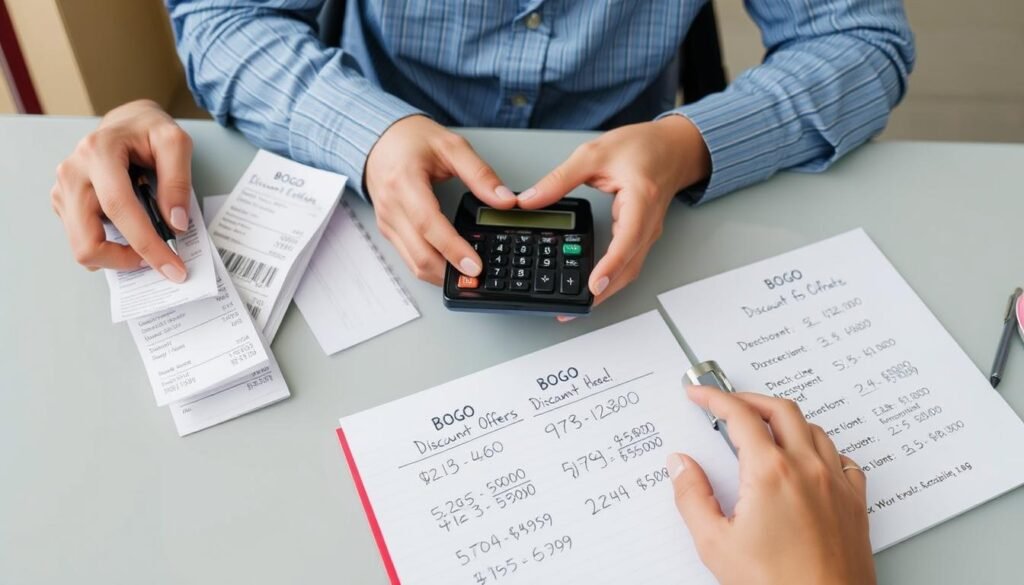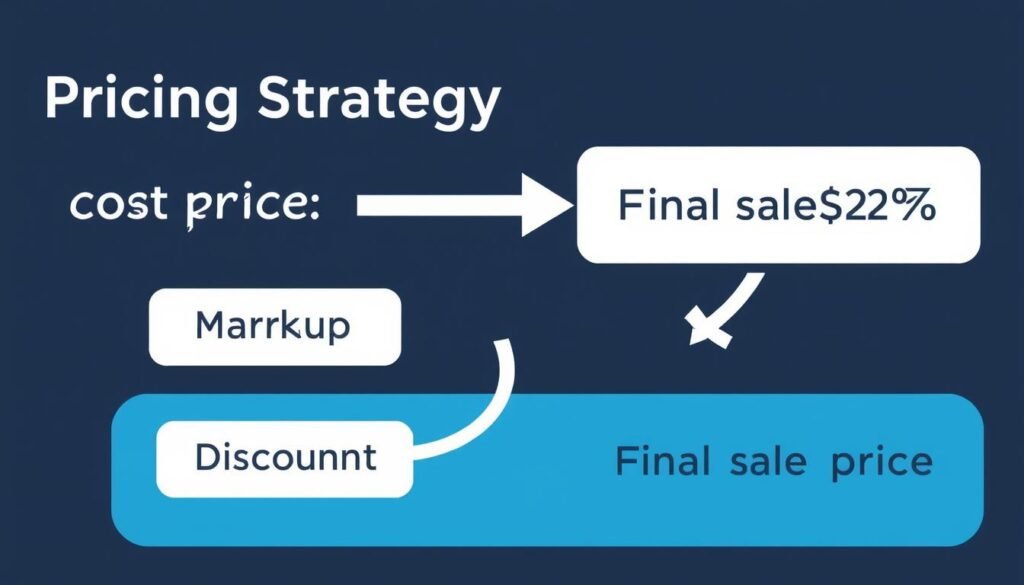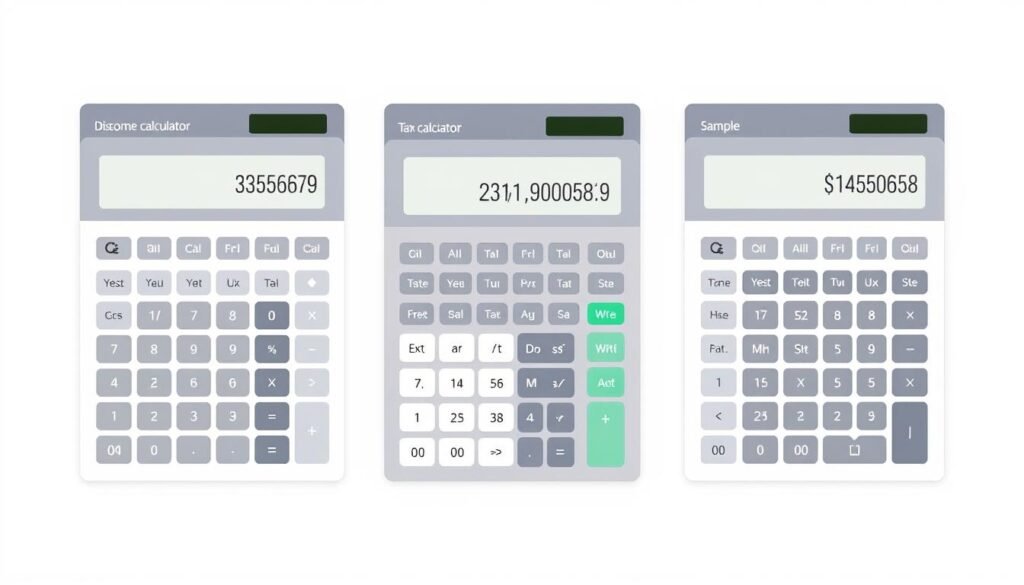Use our Discount Calculator to find discounted prices and savings instantly. Make smarter shopping and pricing decisions with accurate calculations.
Shopping for deals? Our discount calculator helps you quickly determine final prices after discounts, calculate percentage savings, and compare different offers. Whether you’re a savvy shopper hunting for bargains or a business owner setting promotional prices, this free tool makes discount calculations simple and accurate.
Discount Calculator Tool
Use our easy-to-use discount calculator below to instantly find out how much you’ll save and what you’ll pay after applying a discount.
Discount Calculator
Enter the original price and discount percentage to calculate your savings and final price.
Your Results
Original Price: $0.00
Discount Amount: $0.00
Discount Rate: 0%
Final Price: $0.00

Our discount calculator helps you make informed purchasing decisions by instantly showing your savings.
What is a Discount?
A discount is a reduction in the original price of a product or service. Retailers and service providers offer discounts for various reasons: to attract new customers, clear inventory, reward loyal customers, or boost sales during slow periods.
Common Discount Types
- Percentage discounts (10%, 25%, 50% off)
- Fixed amount discounts ($5 off, $20 off)
- Buy one get one free (BOGO) offers
- Bulk purchase discounts
- Seasonal or holiday sales
- Loyalty program discounts
- Clearance or closeout sales
Benefits of Calculating Discounts
- Know exactly how much you’ll save
- Compare different promotional offers
- Avoid impulse purchases based on perceived savings
- Budget more effectively for sales
- Determine if a “sale” is actually a good deal
- Calculate tax implications on discounted items
Ready to Calculate Your Savings?
Use our free discount calculator to instantly see how much you’ll save on your next purchase.
Discount Calculation Formulas
Understanding the basic formulas behind discount calculations helps you verify savings and make better purchasing decisions. Here are the essential formulas used in our discount calculator:
Percentage Discount
Discount Amount = Original Price × (Discount Percentage ÷ 100)
Final Price = Original Price – Discount Amount
Example: A $50 item with 20% off
Discount: $50 × (20 ÷ 100) = $10
Final Price: $50 – $10 = $40
Fixed Amount Discount
Final Price = Original Price – Discount Amount
Discount Percentage = (Discount Amount ÷ Original Price) × 100
Example: A $75 item with $15 off
Final Price: $75 – $15 = $60
Discount Percentage: ($15 ÷ $75) × 100 = 20%
Finding Original Price
Original Price = Final Price ÷ (1 – (Discount Percentage ÷ 100))
Example: An item costs $24 after a 25% discount
Original Price: $24 ÷ (1 – (25 ÷ 100))
Original Price: $24 ÷ 0.75 = $32

These formulas form the mathematical foundation of our discount calculator, ensuring accurate results every time you calculate savings on sale items.
“Understanding how discounts are calculated helps consumers make more informed decisions and avoid the psychological trap of buying something just because it’s on sale.”
How to Calculate Discounts Step-by-Step
While our discount calculator automates the process, knowing how to calculate discounts manually is a valuable skill. Follow these steps to calculate different types of discounts:
Calculating Percentage Discounts
- Identify the original price of the item
- Convert the discount percentage to a decimal (divide by 100)
- Multiply the original price by this decimal to find the discount amount
- Subtract the discount amount from the original price to get the final price
Example: Calculate a 30% discount on a $80 item
1. Original price = $80
2. Convert 30% to decimal: 30 ÷ 100 = 0.3
3. Discount amount = $80 × 0.3 = $24
4. Final price = $80 – $24 = $56
Calculating Fixed Amount Discounts
- Identify the original price of the item
- Subtract the fixed discount amount from the original price
- To find the discount percentage, divide the discount amount by the original price and multiply by 100
Example: Calculate the final price and discount percentage for a $120 item with a $30 discount
1. Original price = $120
2. Final price = $120 – $30 = $90
3. Discount percentage = ($30 ÷ $120) × 100 = 25%
Calculating BOGO and Complex Discounts
For “Buy One Get One” (BOGO) or other complex offers, you need to consider the total value and effective discount:
| Offer Type | Calculation Method | Effective Discount |
| Buy One Get One Free (BOGO) | Pay for 1 item, get 2 items total | 50% off each item |
| Buy One Get One 50% Off | Full price + (Price × 0.5) | 25% off total purchase |
| Buy 2 Get 1 Free | Pay for 2 items, get 3 items total | 33.3% off each item |
| Spend $100 Get $20 Off | Subtract fixed amount if threshold met | 20% off minimum purchase |

Save Time with Our Discount Calculator
Skip the manual calculations and get instant results with our free online tool.
Types of Discounts Explained
Different discount types serve various purposes for both businesses and consumers. Understanding these distinctions helps you identify the best deals and calculate savings accurately.
Common Consumer Discounts
- Percentage Discounts: The most common type, offering a percent off the original price (10%, 25%, 50%, etc.)
- Fixed Amount Discounts: A specific dollar amount off the original price ($5 off, $10 off, etc.)
- BOGO Offers: Buy one item, get another free or at a reduced price
- Seasonal Sales: Discounts offered during specific times (Black Friday, end-of-season clearance)
- Loyalty Discounts: Special pricing for repeat customers or members
Business Discount Types
- Trade Discounts: Reductions offered to wholesalers and retailers in the distribution chain
- Quantity Discounts: Price reductions for bulk purchases
- Cash Discounts: Incentives for prompt payment (e.g., 2/10 net 30)
- Promotional Discounts: Temporary price reductions to boost sales or clear inventory
- Psychological Pricing: Prices set just below round numbers (e.g., $9.99 instead of $10)

Understanding Discount Psychology
Retailers strategically use different discount types to influence consumer behavior. Being aware of these tactics can help you make more rational purchasing decisions:
Common Discount Tactics
- Anchor Pricing: Showing an inflated “original” price to make the discount seem larger
- Limited-Time Offers: Creating urgency with time-limited discounts
- Threshold Discounts: Offering discounts only after spending a minimum amount
- Loss Leaders: Heavily discounting popular items to drive store traffic
Smart Consumer Strategies
- Calculate the actual savings, not just the advertised percentage
- Compare final prices across different retailers, not just discount percentages
- Track prices over time to identify genuine sales versus regular pricing
- Consider the total cost including shipping, taxes, and other fees
Our discount calculator helps you cut through marketing tactics by showing the exact dollar amount you’ll save, making it easier to determine if a “deal” is truly worthwhile.
Compare Different Discount Types
Use our calculator to see which offer gives you the best value.
Practical Discount Calculation Examples
Let’s explore some real-world scenarios where our discount calculator proves invaluable for making smart purchasing decisions.
Example 1: Comparing Percentage vs. Fixed Discounts
You’re shopping for a laptop with these two offers:
Store A: $800 laptop with 15% off
Store B: $850 laptop with $120 fixed discount
Which is the better deal?
Store A discount: $800 × 0.15 = $120 off → Final price: $680
Store B discount: $850 – $120 = $730
Result: Store A offers the better deal by $50
Example 2: Calculating Stacked Discounts
A clothing store offers 25% off everything, plus an additional 10% off for loyalty members.
For a $100 jacket:
First discount: $100 × 0.25 = $25 off → $75
Second discount: $75 × 0.10 = $7.50 off → $67.50
Total savings: $32.50 (32.5% effective discount)
Note: This is different from a single 35% discount, which would be $35 off!

Example 3: BOGO and Multi-Buy Offers
A store has a “Buy 2 Get 1 Free” offer on t-shirts priced at $20 each.
Without offer: 3 shirts × $20 = $60
With offer: 2 shirts × $20 = $40 (third shirt free)
Savings: $20
Effective discount per shirt: $20 ÷ 3 = $6.67 off each shirt (33.3% off each)
Example 4: Finding the Original Price
You see a jacket on sale for $63 after a 30% discount. What was the original price?
Original Price = Final Price ÷ (1 – (Discount Percentage ÷ 100))
Original Price = $63 ÷ (1 – (30 ÷ 100))
Original Price = $63 ÷ 0.7 = $90
These examples demonstrate how our discount calculator can help you navigate complex discount scenarios and make informed purchasing decisions.
Calculate Your Own Scenarios
Try our discount calculator with your own shopping examples.
Advanced Discount Calculation Topics
For those looking to deepen their understanding of discount calculations, here are some advanced concepts our calculator can help with:
Calculating Discount Rate from Original and Sale Prices
If you know the original price and the sale price, you can determine the discount percentage:
Discount Percentage = ((Original Price – Sale Price) ÷ Original Price) × 100
Example: An item originally priced at $50 is on sale for $35
Discount Percentage = (($50 – $35) ÷ $50) × 100
Discount Percentage = ($15 ÷ $50) × 100 = 30%
Understanding Markup vs. Discount
Markup and discount are related but different concepts in pricing:
Markup
Markup is the amount added to the cost price to determine the selling price.
Markup Percentage = ((Selling Price – Cost) ÷ Cost) × 100
Example: If an item costs $40 to produce and sells for $60:
Markup = (($60 – $40) ÷ $40) × 100 = 50%
Discount
Discount is the reduction from the original selling price.
Discount Percentage = ((Original Price – Sale Price) ÷ Original Price) × 100
Example: If an item originally priced at $60 is sold for $48:
Discount = (($60 – $48) ÷ $60) × 100 = 20%

Tax Considerations with Discounts
When calculating the final price of discounted items, it’s important to understand how taxes are applied:
| Scenario | Calculation Method | Example (8% Tax Rate) |
| Tax Applied After Discount | (Original Price – Discount) × (1 + Tax Rate) | $100 item with 20% off: ($100 – $20) × 1.08 = $86.40 |
| Tax Applied Before Discount | (Original Price × (1 + Tax Rate)) – Discount | $100 item with $20 off: ($100 × 1.08) – $20 = $88.00 |
| Discount on Tax-Inclusive Price | (Original Price × (1 + Tax Rate)) × (1 – Discount Rate) | $100 item with 20% off: ($100 × 1.08) × 0.8 = $86.40 |
Our discount calculator can help you navigate these complex scenarios to determine the true final price after both discounts and taxes are applied.
Need More Advanced Calculations?
Try our related calculators for more specialized financial calculations.
Frequently Asked Questions About Discount Calculations
How do I calculate a 20% discount?
To calculate a 20% discount:
- Multiply the original price by 0.2 (20/100) to find the discount amount
- Subtract this amount from the original price to get the final price
Example: For a item with 20% off
Discount amount: × 0.2 =
Final price: – =
What’s the difference between a discount and a rebate?
A discount is an immediate reduction in price at the time of purchase. A rebate is a partial refund offered after the purchase has been made, typically requiring the customer to submit a form or application. While discounts reduce the price immediately, rebates require an additional step and come later, often in the form of a check or account credit.
How do I calculate the original price if I only know the sale price and discount percentage?
To find the original price when you know the sale price and discount percentage:
Original Price = Sale Price ÷ (1 – (Discount Percentage ÷ 100))
Example: If an item costs after a 20% discount:
Original Price = ÷ (1 – (20 ÷ 100))
Original Price = ÷ 0.8 =
How do stacked discounts work?
Stacked discounts are multiple discounts applied sequentially. Each discount is calculated based on the price after the previous discount has been applied, not on the original price.
Example: A 0 item with 20% off, then an additional 10% off:
First discount: 0 × 0.2 = off →
Second discount: × 0.1 = off →
Total savings: (28% effective discount)
Note that this is different from a single 30% discount, which would save .
Are discounts calculated before or after tax?
In most retail settings in the United States, discounts are applied to the pre-tax price, and then sales tax is calculated on the discounted amount. However, this can vary by region and type of promotion. Some rebates or coupons may be applied after tax. Our discount calculator allows you to specify whether tax is included in your calculations.
What is a “fake” discount?
A “fake” discount occurs when retailers artificially inflate the original price to make the discount seem larger than it actually is. For example, marking an item as “0 now (40% off)” when the item was never actually sold at 0. This practice, sometimes called “price anchoring,” is regulated in many countries to protect consumers from deceptive pricing.

Conclusion: Master Discount Calculations with Our Free Tool
Understanding how to calculate discounts accurately is an essential skill for both savvy shoppers and business owners. Our free discount calculator makes this process simple, allowing you to quickly determine savings, final prices, and compare different promotional offers.
Whether you’re calculating a simple percentage discount, figuring out the value of a BOGO offer, or determining the original price of a discounted item, our calculator provides accurate results instantly. By understanding the true value of discounts, you can make more informed purchasing decisions and avoid falling for deceptive pricing tactics.
Start Calculating Your Savings Today
Use our free discount calculator to make smarter shopping decisions and maximize your savings.
For more helpful financial tools and calculators, explore the full range of resources available at CalculatorHunt.com.
